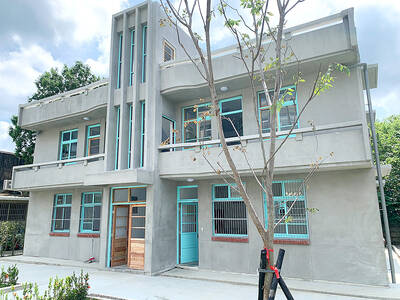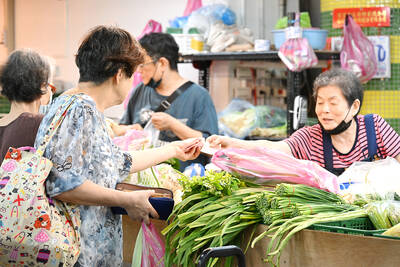The sixth annual Taipei International Jazz Festival closes its seven-weekend run with concerts tonight and tomorrow at Da-an Forest Park (大安森林公園).
The festivities start this afternoon with parades performing Afro-Cuban and New Orleans traditional marching music, played by students from the festival’s jazz learning camp. Percussion shakers will be passed out to any spectators that wish to join in.
The event culminates in concerts tonight and tomorrow, featuring nine guest artists from the US and Europe, as well as several Taiwanese musicians.
The performers, including American pianist John Beasley, Belgian vocalist David Linx and German guitarist Joachim Schoenecker, have spent the past week teaching at the Taipei International Summer Jazz Academy, the annual weeklong camp connected to the festival.
But the concerts won’t just be lessons in jazz improv, they will be “more artistic than educational,” says Hsieh Chi-pin (謝啟彬), a jazz violinist and one of the festival’s founders and organizers.
Since it began in 2004, the festival, which was founded by Hsieh and his wife, pianist Chang Kai-ya (張凱雅), has been tied to their interest in promoting jazz as music with substance.
“It’s not about a beautiful girl or a sexy saxophonist standing on stage,” says Hsieh.
To break down this misconception among local audiences, Hsieh and Chang set up a foundation for jazz with a unique Taiwanese flavor.
In camp sessions over the years, they have encouraged students to compose original songs inspired by their surroundings and adapt classic Taiwanese folk songs for jazz performance.
“We have a Western standard, but we also try to fuse it with material that people are familiar with,” says Hsieh.
One former student, bassist Jeremy Lin (林后進), composed a song about Zhongxiao Fuxing MRT Station (忠孝復興捷運站), which Hsieh says received a strong response from the audience at a festival show earlier this month. The Anne Paceo Trio, which performed several weeks ago, also pleased its audience with a rendition of a well-known Taiwanese folk number.
The festival has also watched its audiences mature. In earlier editions, emcees had to coach attendees on basic etiquette such as clapping after solos. This is no longer necessary, says Hsieh, adding there has been “less talk” on stage at this year’s festival.
Better yet, audiences nowadays seem more genuinely interested in hearing a “fine jazz music program,” he says.
Despite the art form’s American roots, Hsieh and Chang have tried to stress jazz’s current diversity.
While most of this year’s performers were from the US and Europe, Hsieh says he is glad to have included in this year’s program the a.s.k Trio, which played last week and is composed of a South African, a Japanese and a Dutchman.
“Jazz has an identity in every country,” says Hsieh. “Jazz isn’t just American standards, like Broadway [songs]... anything can be jazz and many people can play jazz.”
Festival notes:
What: Final concerts of the Taipei International Jazz Festival
When: Tonight and Tomorrow at 7pm, afternoon jazz parades run today and tomorrow from 4:30pm to 6:30pm
Where: Da-an Forest Park (大安森林公園)
On the Net: blog.yam.com/tijs2009en/article/21438676; www.taipeijazz.com

June 2 to June 8 Taiwan’s woodcutters believe that if they see even one speck of red in their cooked rice, no matter how small, an accident is going to happen. Peng Chin-tian (彭錦田) swears that this has proven to be true at every stop during his decades-long career in the logging industry. Along with mining, timber harvesting was once considered the most dangerous profession in Taiwan. Not only were mishaps common during all stages of processing, it was difficult to transport the injured to get medical treatment. Many died during the arduous journey. Peng recounts some of his accidents in

“Why does Taiwan identity decline?”a group of researchers lead by University of Nevada political scientist Austin Wang (王宏恩) asked in a recent paper. After all, it is not difficult to explain the rise in Taiwanese identity after the early 1990s. But no model predicted its decline during the 2016-2018 period, they say. After testing various alternative explanations, Wang et al argue that the fall-off in Taiwanese identity during that period is related to voter hedging based on the performance of the Democratic Progressive Party (DPP). Since the DPP is perceived as the guardian of Taiwan identity, when it performs well,

The Taiwan People’s Party (TPP) on May 18 held a rally in Taichung to mark the anniversary of President William Lai’s (賴清德) inauguration on May 20. The title of the rally could be loosely translated to “May 18 recall fraudulent goods” (518退貨ㄌㄨㄚˋ!). Unlike in English, where the terms are the same, “recall” (退貨) in this context refers to product recalls due to damaged, defective or fraudulent merchandise, not the political recalls (罷免) currently dominating the headlines. I attended the rally to determine if the impression was correct that the TPP under party Chairman Huang Kuo-Chang (黃國昌) had little of a

At Computex 2025, Nvidia CEO Jensen Huang (黃仁勳) urged the government to subsidize AI. “All schools in Taiwan must integrate AI into their curricula,” he declared. A few months earlier, he said, “If I were a student today, I’d immediately start using tools like ChatGPT, Gemini Pro and Grok to learn, write and accelerate my thinking.” Huang sees the AI-bullet train leaving the station. And as one of its drivers, he’s worried about youth not getting on board — bad for their careers, and bad for his workforce. As a semiconductor supply-chain powerhouse and AI hub wannabe, Taiwan is seeing